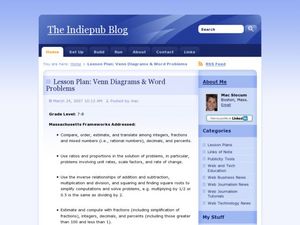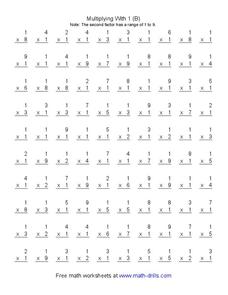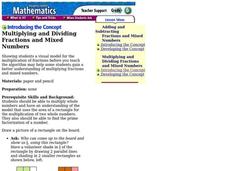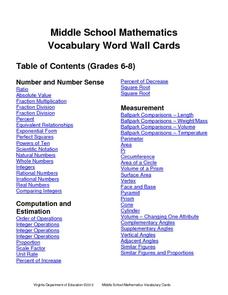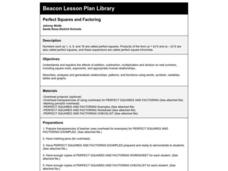Curated OER
Investigating Division
Students develop math sense as they multiply and divide numbers. In this algebra lesson, students identify the missing numbers in a multiplication and division problem. They use a calculator to help them solve the problems.
Curated OER
Prime and Composite Numbers
Students identify prime and composite numbers. In this prime and composites lesson plan, students are given the rules for identifying prime and composite numbers by the teacher, who gives examples on the board. Individuals then complete...
Curated OER
Multiplying Decimals
In this math worksheet, students complete a page that provides a step by step explanation of how to multiply decimal numbers to the hundredths place. Students answer 8 questions and may choose some extension activities with a partner.
Curated OER
Venn Diagrams & Word Problems
Students explore the concept of Venn Diagrams through word problems. In this Venn Diagram lesson, students solve word problems about groups of people using Venn Diagrams. Students use survey results about MySpace and Facebook in a Venn...
Curated OER
Multiplying With 1 (B)
In this multiplying whole numbers worksheet, students multiply one-digit numbers times one. Students find the products for 100 problems.
Curated OER
Multiplying With 3 (A)
In this multiplying whole numbers activity, students find the products of one-digit numbers times three. Students solve 100 problems.
Curated OER
Multiplying With 3 (B)
In this multiplying whole numbers worksheet, learners multiply one-digit numbers times three. Students find the products for 100 problems.
Curated OER
Multiplying and Dividing Fractions and Mixed Numbers
Help math learners discover how to multiply fractions and mixed numbers. They will explore visual examples of the operations. They also practice solving problems that their instructor models.
Curated OER
Working with Scientific Notation
For this scientific notation worksheet, students are given directions to add, subtract, multiply and divide using scientific notation. They complete twenty four problems and express their answers in scientific notation.
Virginia Department of Education
Mathematics Vocabulary Cards – Grade 4
An excellent way to reinforce math vocabulary in your classroom! Seventy-eight posters focus on number and number sense, computation and estimation, measurement, geometry, probability and statistics, and patterns, functions, and algebra.
Virginia Department of Education
Middle School Mathematics Vocabulary Word Wall Cards
Having a good working knowledge of math vocabulary is so important for learners as they progress through different levels of mathematical learning. Here is 125 pages worth of wonderfully constructed vocabulary and concept review cards....
EngageNY
Polynomial, Rational, and Radical Relationships
This assessment pair goes way beyond simple graphing, factoring and solving polynomial equations, really forcing learners to investigate the math ideas behind the calculations. Short and to-the-point questions build on one another,...
Curriculum Corner
“I Can” Common Core! 3rd Grade Math
Help third graders make sense of the Common Core math standards with this simple checklist. By rewording each standard as an I can statement, children are provided with clear goals to focus on as they participate in math lessons.
Beacon Learning Center
Ten Pins
Multiplying with multiples of 10, 100, and 1,000 provides an opportunity to discuss patterns that arise with zeros. The class uses these patterns to solve problems. Then they rotate through three work stations, including a computer-based...
Curated OER
Developing Strategies for Addition and Subtraction
Primary graders develop strategies to assist them with addition and subtraction. They discover number combinations and numerical facts which enable them to add and subtract more effectively. Students use these techniques to complete...
Willow Tree
Solving Quadratic Equations
Polynomials are full of solutions! Learners understand that the degree determines the number of solutions. Examples show quadratic equations solved by factoring and by using the quadratic formula. A cubic equation is even mixed in for...
PBS
Add, Subtract and Multiply Fractions
Your future chefs will appreciate this comprehensive instructional activity where learners practice operations on fractions using pizza and soup analogies. Learners begin with a pizza analogy that requires the learners to multiply a...
Pennsylvania Department of Education
What is the Chance?
Fourth and fifth graders make predictions using data. In this analyzing data lesson, pupils use experimental data, frequency tables, and line plots to look for patterns in the data in order to determine chance. You will need to make a...
EngageNY
Exponential Notation
Exponentially increase your pupils' understanding of exponents with an activity that asks them to explore the meaning of exponential notation. Scholars learn how to use exponential notation and understand its necessity. They use negative...
Curated OER
Making Arrays
In this making arrays worksheet, students, working with a partner, study and calculate how to make arrays by completing six exercises.
Curated OER
Stock: The Rise and Fall of Stock
Students examine the uncertainties of investing in the stock market. They look at how company profits, good or bad news, and new competition affect share prices. They write and discuss journal entries about share prices before completing...
Curated OER
Operations with Decimals
Help your learners get practice with operations involving decimals. They will follow prescribed steps that require them to use mixed operations to solve problems with decimals. Great for practice after pupils have had comprehensive...
Curated OER
Perfect Squares and Factoring
A teacher guided lesson on perfect squares and factoring. They discuss perfect squares, observe the expansion steps for finding the product, and practice solving problems. They complete a worksheet on perfect squares and factoring.
Curated OER
Building Sets of 13 and 14
Compose and decompose sets of 13 and 14 and compare sets of each with your little learners. They use objects to construct sets of 13 and 14, record their answers, and compare sets in several different ways.





